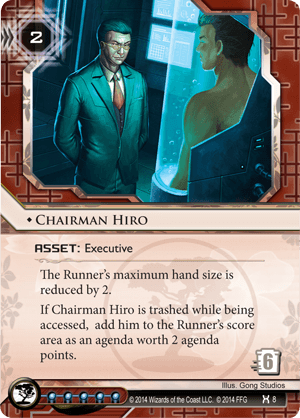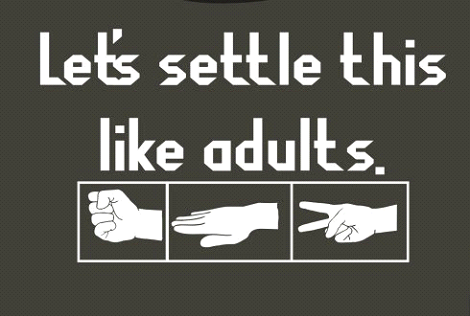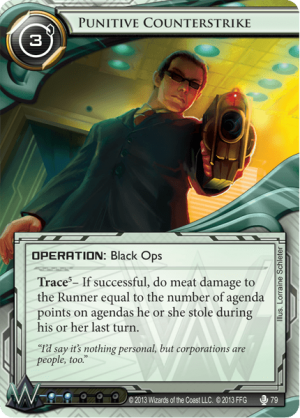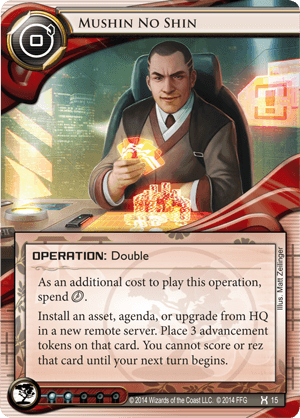This is a guest article from guest author Elusive.
Introduction
When I started playing Netrunner one and a half years ago, I was immediately drawn to Jinteki and Criminal. I’m just that type of player who likes taking risks, calling bluffs and heavy interaction. I like playing a high-stakes game, and I like figuring out my opponents plans and thinking one step ahead. The trick is finding decks to play that reward that playstyle enough.
This deck has been born out of this aim, and iterated on for over a year. When I started, Personal Evolution had a little popularity burst due to the effective Cambridge-type PE deck that has a kill threat but also whittles down the opponent with pokes and needles until their deck runs out. Because of popular runners using a lot of Levy, and with I’ve had worse, this type of deck moved out of popularity.
From the start I tried to focus on the kill-turn instead of the card-bleeding. The idea is to avoid a problem where the deck is more effective against newer players, but you have to count on experienced players to make mistakes.
This has proven quite effective, despite I’ve Had Worse (really, Steelskin was a better name, wasn’t it?).

Introduction to Yomi
The thing I find so fascinating about good games is that the really good matches come down to a single tense moment where everything hinges on a final decision. Did he just place the last 3/2 in the scoring remote, or is it a bluff? Does he think I have my kill-combo, so I can score this before he yanks it from HQ? That moment when you hold your cards tightly to not show that you are shaking a little, and try to give your opponent a casual smile to prevent him from sniffing out that either of you is one move from victory or death.
What happens in those moments is that you are playing a game of reading your opponent, where the game is just a set of rules in which you try to outwit each other. It is not the calculations that matters, it is your judgement of what your opponent believes, and what he believes that you believe, and what you believe that he believes that you believe.
It could be any setting, really. I will use a term coined by a game designer who specialises in that type of game, and he calls it Yomi. This is not really a game about the game as much as a game about psychology, and veers into very different territory from calculated risks (is it worth spending 8 credits for an R&D access?) and tactical play (if I protect my PAD with a pop-up the cost for him to trash it will not be worth it).
For me, this is the best part of games. You will notice that a lot of the Tier 1 decks pride themselves on as much as possible avoiding this sort of situation, this is indeed part of why they are effective. Classic fast-advance and HB-Foodcoats win by creating unbearable situations for the runner using effective tactical play (and powerful synergistic decks). A large reason for their power is that not only are they effective strategies, they are easy to play well once you know them, since tactical play can for the most part be continually improved and played under pressure (tournaments).
Due to the in-built systems of Netrunner, these decks can never get completely away to the safe haven of tactical play, but they sure try their best and succeed very well. However if they did, we would not be playing Netrunner, we would be playing Cyber-Chess. Now who wants that? (except maybe Reina..)
Then how can I argue for Yomi as a strategy in Netrunner? Well the designers of this game, as we all know by now, have proven that they are really clever. For Yomi to be more effective than tactical play we have to create situations where the Yomi-game greatly outweighs options for tactical play. The game allows this. Not only is the Psi-game an excellent example of this (when at least one party is low on credits), but it is possible to create entire deck concepts around it. Maybe the best example of this is Mushin No Shin, as we will see below.
There is a single reason why experienced players avoid playing games of Yomi if they can. A game of Yomi has high variance. Now, variance is not the same as randomness. It simply means that there are large consequences of a choice, but there is no dice-rolling. Both actors make conscious decisions about their moves. It would only be random if there was no way in which you could know what your opponent is thinking, and act to counter that.
This, of course, we know to be false. There are even pro-players in the game of Rock-Paper-Scissors who would most likely kick our butts at it. Let me tell you a secret: the players who avoid learning something usually are not very good at it. This is why I play Personal Evolution.
The Psychology of Reading
From my play experience with Netrunner and with other games there are certain things that can be said about the game of Yomi. There are moments where you are so absolutely certain that you control your opponents every move, and games where you have no idea why you are losing, how he can seem to be inside your head and outwit you at every turn. Most matches are not like this, most fall slightly in between. I call the separating factor in these games ‘mood’. Others have called it tilt, but that only describes the negative part of the spectrum. You may not know it, but there is really a sort of psi-game going on between you and your opponent when you play.
Thing is, to be able to read your opponent, first he or she has to be predictable. Second, you need to pick up on the patterns. Third, you need to have a way to exploit them. In a purely strategic environment, like chess, you do not. The only thing that negative mood does for your opponent is that they might make tactical mistakes, and you are usually not in control of that.
When you have picked up on your opponents pattern of play (he or she might not run advanced remotes, or will always run third click after drawing up) I call this ‘getting a read’ on your opponent. If he is in a negative mood he will be much more vulnerable to this, and if you are you will not be able to do it no matter how experienced you are. I always go into a tournament well-rested, and greet my opponents with a smile. It is important to have good spirits, not only because it creates a better play-environment, it is also for a very competitive reason.
I need to keep my own mood up, otherwise I will not perform. Also, confidence tends to make some opponents wary, which may make them predictable. Always be aware of your own mood, because if you slip, you will not know when you start becoming predictable until you start losing.
An interesting effect of this is that all these things multiply in an environment with high stakes, with tension, and with consequences. I perform better in tournaments than in casual games, and I believe it is because the tournament makes it easier for me to get a read on my opponent. Thus I believe I can claim to play a deck archetype that increases in effectiveness in a tournament environment! How cool is that?
Now listen, you’ve read this far. This is where things start getting weird. If you believe that your opponent has a read on you, how do you counter that? The safe option is to play randomly. Why, you ask? Well, considering you are most likely in a low-mood state you will not be able to judge whether you can turn the tables on your opponent or not. Play randomly, at least then you will absolutely ensure that he cannot read you!
In fact, to play randomly is a good base-strategy in all Yomi-games, but you need to weigh your choices according to the payoffs. In Rock-paper-scissors all choices are equal, but mushining a The Future Perfect may lose you the game if your opponent is on 4pts, but maybe not win you the game if he doesn’t run it? This is not a 50/50 choice. Random play only gets you so far, but it is what you retreat to if on the mood-defensive.
The way-out bluffs, or ‘Surely he would NEVER do that?’
The funny thing about these games is that sometimes, when your mood is high, you can pull of incredible manoeuvres. I only recommend this when desperate, or when your read is very good. Thing is, your opponent usually assumes you use some level of tactical play. That is, you do things that are tactically effective, and avoid objectively ‘bad plays’. Indeed you should usually do this, do not waste your Mushin’s on advancing a Snare!, usually there are better targets.
Thing is, what if doing that type of thing will win you a game? How then, do you ask, does doing objectively bad things win me a game? I will demonstrate with an example:
I was playing one of my regular opponents, he is a really strong tactical player, and makes very few mistakes. I believe I was under heavy pressure, and he had scored 4 or 5 points. My only option was getting a kill somehow, but I didn’t have enough killy stuff, and he surely would never take the risk of running into an advanced trap at this stage. I ‘knew’ this, with the type of mind-reading certainty that you sometimes get. Thing is I didn’t have anything to exploit with that knowledge. I had a Chairman Hiro (oh how I love the little bugger) but my opponent ran all the unadvanced remotes, because he could handle their worst case-scenario, he knew this. That’s when i drew a Mushin. I Mushin’d Hiro, with the belief that he would leave him alone. He did, and this allowed me to kill him a few turns later by bringing him to three cards and using a combination of agendas and Neural EMP’s on my turn.
Now, I hope I made my case reasonably well here, so let’s get into the deck-tech that will enable your psychic powers to come out to play.

The Deck:
Bag of Tricks – V3.0 – We do what we must, because we can.
Jinteki: Personal Evolution (Core Set)
Agenda (10)
3x Fetal AI (Trace Amount)
3x Profiteering (Second Thoughts)
1x Philotic Entanglement (Honor and Profit)
3x The Future Perfect (Honor and Profit)
Asset (13)
1x Project Junebug (Core Set)
3x Snare! (Core Set)
2x Ronin (Future Proof)
2x Cerebral Overwriter (Creation and Control) ••••
3x Jackson Howard (Opening Moves) •••
1x Chairman Hiro (Honor and Profit)
1x Psychic Field (Honor and Profit)
Upgrade (1)
1x Crisium Grid (First Contact) •
Operation (14)
2x Neural EMP (Core Set)
3x Hedge Fund (Core Set)
3x Celebrity Gift (Opening Moves)
2x Punitive Counterstrike (True Colors) ••••
1x Subliminal Messaging (Fear and Loathing)
3x Mushin No Shin (Honor and Profit)
Barrier (3)
3x Markus 1.0 (The Source) •••
Code Gate (2)
1x Yagura (Fear and Loathing)
1x Lockdown (Chrome City)
Sentry (4)
1x Komainu (Honor and Profit)
3x Cortex Lock (The Valley)
ICE (2)
1x Kitsune (First Contact)
1x Excalibur (The Source)
15 influence spent (maximum 15)
20 agenda points (between 20 and 21)
49 cards (min 45)
Cards up to Chrome City
Strategy
The overall goal is to force the opponent to play deadly mindgames, or eventually kill them if they politely decline to play. We do this by building up (mostly) advanced remotes to be able to score a lot of damage on a single turn.
This is why you should leave your agendas on the table until you really need to use them, it is tempting to score that Profiteering, but you should not! Not unless you really need to.
Now, sneaky tactical players try to avoid playing our game by figuring out clever ways to disable it. The deck is constructed to counter most such strategies. The most notable being R&D lock with single accesses, and econ denial.
There are two main win-conditions, the first is to kill them. We are however also able to score out. Rushing a TFP can also entice your opponent to respect your remotes, and consider running them if they didn’t before. It is however a high-risk strategy.
Early Game:
This is when we are weak to R&D accesses, and we have no win-condition. The worst thing that can happen is that they snatch a The Future Perfect before we are set up. We need to lock down R&D, and preferably keep them out of HQ as well. If you are facing econ-denial you need to take steps to counter that, beef up on money before you start deploying your remotes. The threat of Punitive helps here, as no plascrete is on the board. Our scary ice also helps a lot. As soon as the imminent threats are dealt with, you should start setting up advanced remotes. The choice of things to place should be considered thoroughly depending on the read you have on your opponent, and your plans for long-term strategy.
A secondary goal is to get a Jackson out and protect him. He will be of great aid to you as you should be accelerating the game into the mid-game as soon as your primary objectives are accomplished. Jackson also helps hiding some cards when you are using Celebrity Gift.
Mid Game:
Most runners will have a rig set up, and enough money to start digging your R&D. Most shapers and anarchs will attempt this, especially the overly ‘tactical’ player type that is not fond of taking risks. At this stage it should be OK to let them in, because by now you should have a potent kill-threat in-hand (Punitive, Neural EMP) and on the board (Ronin, ready-to-score agendas). At least they have to consider that you do.
At this stage, you want them to make roughly one R&D run per turn, maybe slightly less. Eli helps tax out criminals, but you may also find tools such as Excalibur and Lockdown useful to accomplish this for other runners. The hope is that we will entice them to attempt multi-access runs. Of course, at this point they will access a couple of Fetal AI, Snare! or general agendas resulting in damage and Punitive countermeasures. A strong counter-strategy is to use Medium, or trashing cards to access several single-cards in a turn.
If they start running your remotes this early, you’ll have to win the Yomi game. Be aware of your mood.
Late Game:
At this stage the runner will be sitting on a couple of points (4 or 5), or a plascrete. Probably both. This nullifies your R&D threat considerably. If you have been following my advice, however, you should be sitting at zero points. Now, if you went for the kill-strategy (which you should in most cases) you hopefully have a mix of traps and kill-tools (Ronin, agendas) at your disposal. A good Yomi-runner will know this, and may start running your remotes. This is when you really know if you read them correctly or not. Many will also just continue digging R&D or milling cards (these players are the strategic players, and the easiest opponents IF you managed a read on them early).
So get that last piece you need, dig for the Neural EMP, sneak out the Hiro. Put them out of their misery. After all, we do what we must, because we can.
Card Choices Explained
TFP: It is self-protecting, feeds your Punitive-threat and allows you to score out with Mushin. High risk/high reward type Mushin target.
Fetal AI: Also self-protecting, and sets up a great Punitive counter. In addition it adds to R&D dig damage.
Profiteering: Low-risk/high reward type Mushin target. Your main 0-click kill-tool, that also at the same time gives you absurd amounts of cash for the punitive. These are your safety valves for econ denial as well, but be aware: if you score one early, that is one more damage you need for the kill turn, and you just enabled mid-game whether you like it or not since your Eli’s are now useless. Better be ready.
Philotic: Probably the best kill-tool in the deck. Gives you 3-4 0-click damage for the kill turn. If they steal this you are a very sad panda, so use it wisely.
Junebug/Cerebral: Your main threat, and your greatest bane. This is how you play the Yomi-game, and you need to do it well. A cerebral usually wins you the game, and Junebug can do this. It is also important that the runner has to consider both threats. However, if you just placed a trap that they did not run, don’t consider it a lost investment. You set-back your kill-plan, but they do not know this. Maybe this is what they run later when they are desperate and win you the game? The trick is placing them when the runner is psychologically close to running, and this is a Yomi-question.
Also, don’t use back-channels. Just don’t. Same as scoring an agenda, back-channels removes a threat from the board and you will be less powerful as a consequence. If you start scoring agendas, and using back-channels the runner will know that the things you leave out are most likely not traps or agendas. Not good for you.
Ronin: Low-risk/high-reward Mushin target. Good stuff. Use your cyber-ninjas wisely.
Chairman Hiro: Hiro is your most powerful ally against passive runners. He is so worth the 2 points you sometimes lose. Use him late-game to enable the kill-turn, but be aware that you need to leave him out for a turn for him to do your bidding. Your reward is the blank stare of your opponent when you flip him at the end of their turn, then they know what is coming.
Psychic field: Great protection for Hiro, great card in general. Up’s the threat of your remotes, protects your face-down Jacksons. The only one is to ensure that the threat is there, but to have several would cost valuable slots. It is all about making your opponent expect the worst.
Snare!: Snare? Snare.
Crisium grid: This is a tech-card, and you can consider switching it if your meta differs. It counters account-siphon and Keyhole-runs. However let those shapers in with their Maker’s Eyes!
Neural EMP: Mid-game kill-assistance, and late-game kill-tool. Save them in hand.
Punitive Counterstrike: The deck is built around this card to some extent, but it is not the primary win-con. This is your mid-game kill-tool, but feel free to discard these as soon as a counter hits the board.
Mushin No Shin: The essence of perfection. Use them, Jackson them back in, use them again.
Hedge/Celebrity Gift: Your main econ. Be sneaky with those Gift’s. Don’t think it is always a good idea to show the runner your punitives to scare them off, hidden threats are always more useful. What to show with Gift is situational, but try to hide one or two cards.
Subliminal Messaging: This is a tech-slot, but a good base-card to use. It gives you money, improves Celebrity Gift and entices runs. What’s not to like?
Markus 1.0: Your oh-so necessary tax on R&D, replacing Eli 1.0 due to MWL. I have had time to test this change only a bit, seems to work so far. Might play around with Viper as well, but that means no barriers.
Yagura: Allows some control, forces a code-gate breaker. Assists Eli early game. He can’t do it all by himself after all.
Komainu: The only ice broken by Mimic in this deck. Isn’t that funny? This is the psychic field of ice. It needs to be here to keep the fear alive, and sometimes it wins you games. Also, Faust.
Cortex Lock: The best early-game ice there is. Usually on HQ or in front of remotes, but can protect R&D early as well. This is why they fear you, and it forces rig-install which gives you some extra time.
Lockdown: This card is very interesting, most runners will just run through it. Sometimes this is a good idea, sometimes it is not. It will win you a game, and then you will love it. It is situational however, but usually goes on R&D mid-game.
Excalibur: This card goes on R&D mid-game. It forces the runner to make those single run multi-accesses that we all know and love.
Kitsune: Did they just run last click, or third? Is their rig out and they feel safe yet? Why not reward them with some Snare! or Fetal AI? They surely deserved it. This means your ice is dangerous even after breakers are out.
Weaknesses
This deck is considered Tier 2. This is because it has a bunch of strategic counters that are very effective, but also because it is indeed difficult to play correctly, due to the nature of Yomi. The main threats I have dealt with such as R&D lock and econ denial. I will mention some things that require more from you if they show up:
Specific counter-tech: These are cards such as Feedback Filter and Deus Ex. To some extent also Film critic. I do not consider Plascrete a counter, because you should count on that thing showing up. Apart from briefly reveling in the fact that your opponent specifically counters your T2 deck, know that these cards make players much more inclined to run remotes and take risks. 4-advance your Cerebrals, and otherwise make them use up their clone-chips.
Sooner or later the last Deux-ex will start having value for them, this is when you can start trying to score out.
If you suspect net-damage counters, you can attempt to score out at the start. This is because a player who knows they have such a counter in their deck will search for it before starting to run. Especially shaper-players who like to feel safe, and in control.
Anarch milling: In the form of Noise, Keyhole or Data Leak Reversal. Similarly to shapers, if these players believe they have a strong game-plan by playing solitaire, they will go for it instead of taking risks. This allows you to focus less on traps and more on the kill, or indeed scoring out. These types of players also like feeling safe, and are usually very attached to their game-plan. You can exploit this by rushing.
Apex: Just.. don’t. I do not think attempting to kill sentient AI is a good idea, luckily this is not a viable tournament deck at the moment.
Final Words
I believe that if you put your mind to it, and learn to play Yomi, in your hands this deck can edge closer to Tier 1. This is because it has such a strong matchup against so many types of players. The tactical, careful players that tend like the safety of their low-variance decks are usually the ones that inhabit the top tables. However, watch out for the Poker pro’s 😉
Tactical players will sometimes scoff at playing a deck with this high variance, but the really good players know that the games they win against equally skilled opponents are often due to Yomi play. If the matchup is equal, and the players are equal in strategic strength, games of the mind are the only thing left (discounting luck-of-the-draw).
However mastering it, and mastering the game of mind-reading will not only improve your performance with this deck, it will improve all of your Netrunner play, becasue Yomi is a part of the game. When you start learning how to exploit your opponents patterns of play, you will win more with any deck.
Elusive







